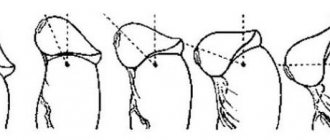Harm of X-rays for pregnant women
Sometimes, while expecting a child, women need to sanitize their oral cavity. And in order to properly plan therapy, an orthopantomogram is often required. “Is it possible to take dental x-rays during pregnancy? What are the consequences? - expectant mothers often worry.Indeed, irradiation is undesirable during this crucial period. But in reality, not everything is as scary as you might think at first glance.
Dental X-ray during early pregnancy
Directly in the first trimester, the risk of undesirable consequences is the highest, since this is when the baby’s organs are formed. For this reason, doctors do not recommend taking dental x-rays during early pregnancy. After all, cells during active division are very sensitive.
However, many doctors believe that, unlike an X-ray of the back or pelvis, a dental X-ray during pregnancy is not aimed directly at the area where the embryo is located. Therefore, do not worry if you did it before you found out about the joyful event.
In addition, dental x-rays during early pregnancy are allowed in emergency cases when, for example, there is a threat to life. In other situations, it is better to postpone dental x-rays during pregnancy to a more successful period, namely, to the second trimester.
Diagnostic results: interpretation of images
The contrast agent does not transmit x-rays, and the cavities filled with it are visible on the image as bright white spots. An indicator of good tube patency is the spreading of the contrast agent along the peritoneum to areas remote from the insertion site. If the contrast stops at any section of the fallopian tube, it means that there is an adhesion or other pathology in this place. Depending on the shape of the uterus and tubes, the doctor can determine which pathological process is preventing conception. Interpreting images of the uterus and fallopian tubes requires extensive knowledge and considerable practical experience. Self-diagnosis is a completely useless exercise.
If the results of the examination give reason to suspect the presence of uterine cancer, it is necessary to order additional examinations, including taking tissue for a biopsy. The diagnostic doctor's conclusion, along with the photographs, is transmitted to the attending physician who referred the woman for examination.
Interpreting images of the uterus and fallopian tubes requires extensive knowledge and considerable practical experience. Self-diagnosis is a completely useless exercise.
Is it possible to take dental x-rays during pregnancy?
To answer the pressing question “Is it possible to have a dental x-ray during pregnancy?” dentists answer that it is not an absolute contraindication for its implementation. Therefore, if such a study is extremely necessary for the expectant mother, it can be done. The main thing is to follow simple rules:
- So, you can take a dental x-ray during pregnancy, preferably in the second trimester. At earlier or later dates, it is better to refrain from carrying it out.
- To obtain minimal radiation exposure, you can take dental x-rays during pregnancy not with a film fluorograph, but with a computer visiograph.
- During pregnancy, you need to tell the radiologist about it and indicate the due date.
- It is necessary to cover the chest and abdomen with a special protective apron before the examination.
You should also discuss whether it is possible to have a dental x-ray during pregnancy specifically in your case with the gynecologist you are seeing. Perhaps, in order to avoid undesirable consequences, he will have his own opinion.
Preparation for hysterosalpingography
If the gynecologist has not identified any contraindications to x-raying the uterine tubes, you can begin to prepare for the procedure. You should abstain from sexual intercourse for 2 days before the examination. A week before the x-ray, you need to stop douching, using intimate hygiene products, as well as any vaginal suppositories, sprays and gels.
Also, as a preparation, the doctor usually directs the woman to undergo general blood and urine tests and a smear for flora. Before conducting the examination, it is necessary to make sure that there are no pathogenic microflora in the vagina, since catheterization of the uterus in this case can lead to infection entering its cavity.
Typically, an X-ray of the fallopian tubes is performed within the first 2 weeks after the end of menstruation. The mucous membrane of the uterus during this period has a relatively small thickness, which facilitates insertion of the cannula.
How are uterine tubes x-rayed?
An x-ray of the fallopian tubes consists of two stages - the introduction of contrast and the x-ray itself. After a general gynecological examination, the doctor inserts a small tube (cannula) into the cervix, through which a contrast agent is poured into the uterine cavity using a syringe - a special liquid that blocks x-rays. The doctor then takes several pictures of the uterus and fallopian tubes. After the procedure, the tube is removed, and the contrast liquid is quickly absorbed into the blood and eliminated from the body without any harm to health and well-being. Nowadays, for X-rays of the fallopian tubes with contrast, iodine-containing preparations such as Verografin, Urografin, Triombrast, Ultravist and others are used.
The procedure usually does not cause severe pain or discomfort. The sensations during it are reminiscent of the pain syndrome in the first few days of menstruation. In this regard, most often, the use of anesthesia is not required. However, if the patient knows that the first days of her menstruation are very painful, and if there are no contraindications to the use of anesthesia, the doctor can perform local anesthesia before starting the diagnosis - a small amount of anesthetic is injected into the uterine cavity before the procedure. General anesthesia is not used for this procedure.
Most women tolerate this examination well, but some complain of discomfort or mild pain in the lower abdomen, which goes away 20-30 minutes after the end of the examination.
An interesting fact is that in a number of cases, long-awaited pregnancy in patients occurred almost immediately after an X-ray of the fallopian tubes was performed. The reason for this phenomenon is that minor adhesions are removed under the pressure of the contrast agent.
After x-ray of the fallopian tubes
After an X-ray of the uterus with contrast, there may be slight bleeding or watery vaginal discharge, mild pain or discomfort in the lower abdomen. As a rule, these symptoms go away on their own, and you should only consult a doctor if they last more than 3 days. For 2-3 days after hysterosalpingography, you should not use tampons (only regular pads), douche, go to the sauna or take a bath. These days it is better to limit yourself to a shower. You should also refrain from sexual intercourse - the cervix dilates during the examination, which can facilitate the penetration of infection. Sometimes after the examination there is a slight delay in menstruation.
Reasons to immediately consult a doctor include excessive bleeding or discharge with an unpleasant odor, fever, nausea and severe pain - all of this can be a sign of infection.
The need for x-rays before pregnancy
An X-ray examination performed during pregnancy planning may be needed in different cases. For example, in the absence of fluorography. It may be required at work if this period coincides with the next preventive medical examination. Or the expectant mother simply has not undergone such an examination for a long time, and now, in preparation for conception, she will have to do it.
Another option for x-ray examination is dental treatment. Before pregnancy, it is advisable to carry out a complete sanitation of the oral cavity to exclude foci of infection. Often during dental treatment, especially in cases of dental problems, it is necessary to take an x-ray.
Before planning a pregnancy, it is necessary to sanitize your teeth
There are situations when, in order to undergo a full examination before conception, the doctor, in addition to directions for tests, prescribes an X-ray examination of the abdominal organs. This procedure is especially necessary when you need to check the patency of the fallopian tubes.
Pregnancy after x-ray.
Tryam, hello! My name is Dasha. I am in my 9th week of pregnancy (according to the date of ovulation) and the 11th obstetric, today I went to the second ultrasound (as part of registration in the residential complex of the Moscow Region city of Klin), the results did not please me at all: they scared me terribly, I sit and I'm shedding tears. Maybe someone had such a situation?
And the situation is as follows:
My last period was on May 20th. On June 15, my jaw hurt terribly and the dentist forced me to take an x-ray. I didn’t know about pregnancy (I started taking tests only on 24 DC, 25 DC and 1 DC - on June 18, 19 and 20), there were no signs at all, so I calmly went for diagnostics. They put me on a protective apron, a photo was successfully taken in two projections, the doctor made a diagnosis and prescribed treatment (anti-inflammatory drugs and procedures with a surgeon). Before I had time to cure my long-suffering teeth, early toxicosis began and my chest began to hurt alarmingly. I did the tests: they, of course, turned out to be positive. I was, of course, incredibly happy (they had planned it since March, but it didn’t work out) and at the same time unpleasantly shocked: after all, I had an x-ray done, endured anesthesia (ultracaine), and took serious medications. What kind of hedgehog will be born now?..
The Internet, oddly enough, reassured me: everything will be fine, blah blah blah. I had my first ultrasound at 4.3 weeks at the Center: I explained my problem to the doctor, who reassured me, saying that the fertilized egg was on time, of the correct shape, in the uterus, the yolk sac was in place - everything was OK! They prescribed me folic acid and lots and lots of fresh vegetables/fruits. I calmed down. Today I came to register at the Klin residential complex, they sent me for an ultrasound:
— Embryo with CTE at exactly 8.5 weeks and SB (heart rate 150 beats/min)
— There are no threats, there is one fertilized egg in the uterus
— Bicornuate uterus (fetus in the right “horn”)
Without explanation or analysis for progesterone, I am prescribed duphaston (1 tablet 3 times a day - a horse dose) and referred to the district gynecologist. She sets up an exchange for me based on the ultrasound (attention, without examination and measurements), asks questions. Asks if there have been any illnesses/x-rays/antibiotics taken in the last 3-4 months. I tell her about the tooth. What begins! She yells that this is 100% 3D, that there will be severe pathologies, that in my case, only for an abortion. I'm crying. Writes me a referral for cleaning! Naturally, I won’t go anywhere: there is a person, there is a heart beating! What, kill him? No!
Please reassure me, girls! Maybe someone had similar cases? How did the pregnancy develop? What to tune in to?
And my Lyalya is such a sweetheart! Look, what kind of abortion is this?.. Photo:
What do doctors think?
Doctors do not have a consensus on the effect of X-ray radiation on the unborn child at the planning stage. Some claim that it is absolutely safe and will not cause any harm.
Others say that there is still a certain percentage of negative impact, but it depends on the frequency of exposure over any period of time.
What should you do if, at the stage of pregnancy planning, you have to visit an x-ray room? How long before you can think about conceiving? It is clear that you still need to undergo an examination, and there is no escape from it. Therefore, it is best to count the days of the menstrual cycle. It is not recommended to take x-rays in the second and last third. However, this applies to x-rays of the pelvis or lower spine. If you are a very suspicious person who avoids pills, microwaves and computers, then you can postpone conception until the next menstrual cycle, so as not to worry then for the entire nine months.
Examination of men when planning to conceive a child
Zavyalova Ekaterina Sergeevna
Urologist
October 28, 2014
Pregnancy planning and the associated medical examination very often rest entirely with the woman, and the man does not participate in the process. A woman’s health really plays a vital role, since she not only has to conceive, but also bears a child. But a man should also undergo some tests to avoid unpleasant surprises during pregnancy.
We are talking, first of all, about sexually transmitted infections. These tests are worth repeating even if you took them while you were already married and your partner was recently tested for the same infections. This is due to the following nuances:
- The diagnostic sensitivity of the PCR (polymerase chain reaction) method, which is routinely used for screening sexually transmitted infections, is 95-100%. As you can see, even such an ultra-sensitive method as PCR does not give 100% correct results.
- False-negative test results are possible due to the presence of inhibitors (substances that suppress the PCR reaction) in the collected material. Inhibitors can be detergents (in particular, those containing lauryl sulfate), some antiviral drugs, anticoagulants (for example, heparin), blood, purulent discharge, cervical mucus, leukocytes, microbial polysaccharides, salt crystals contained in urine, nitrites, hCG.
- A number of sexually transmitted infections are opportunistic, that is, living in small quantities as part of the normal microflora. At the same time, opportunistic flora can cause inflammation not only through direct transmission from a partner, but also as a consequence of dysbiotic processes caused by recent use of antibiotics, weakened immunity, etc. The composition of the microflora in men and women is different. This circumstance is often associated with different results between partners.
Pregnancy is a state of physiological immunodeficiency. If a woman is doing well at the time of pregnancy, and you have one of the opportunistic infections, if her immunity is weakened during pregnancy, it can be transmitted sexually with the subsequent development of an inflammatory process.
Thus, it makes sense to be examined for the following infections:
- Neisseria gonorrhoeae
- Trichomonas vaginalis
- Chlamydia trachomatis
- Mycoplasma genitalium
- Mycioplasma hominis
- Ureaplasma urealyticum
- Herpes virus 1 et 2 type
- HPV infection
To take a spermogram or not to take a spermogram? The question is almost philosophical, if everything is in order with your health. There are no recommendations to have this test done before conception. It is usually recommended if pregnancy does not occur within six months to a year. If you still want to do an analysis of the fertilizing ability of sperm, then in order to avoid unnecessary worries about possible deviations from the norm, it is better to get comments from a specialist.
Our recommendation to visit a urologist with the results of a spermogram is due to the fact that even in completely healthy men, the indicators of this analysis can have very significant fluctuations, which cannot have a serious impact on the likelihood of pregnancy. Often, not very significant changes are interpreted as bad even by gynecologists, to whom the wives of men come for comments. In addition, different laboratories use different standards for spermogram indicators, which also introduces additional difficulties in interpreting the results.
BUT: there are pathologies in which it is recommended to perform a spermogram, since the likelihood of a serious decrease in indicators is quite high. In this case, you will gain time by starting treatment or immediately resorting to auxiliary methods of reproduction:
- Cryptorchidism (undescended testicles is the cause of infertility in 7.8% of cases). Disturbances in the process of sperm maturation are more likely with bilateral cryptorchidism, even after timely surgical reduction of the testicles.
- Varicocele in the absence of surgical treatment (dilation of the veins of the spermatic cord, the cause of infertility in 15.6%).
- Endocrine pathology (8.9%). The most important place is occupied by congenital genetic syndromes, such as Klinefelter syndrome, Kallman syndrome, Noonan syndrome, dominant variant of polycystic kidney disease and others. Acquired pathology of organs such as the pituitary gland, adrenal glands, and thyroid gland can also affect the quality of sperm.
- Testicular injury.
- Testicular torsion in childhood or adulthood.
- Orchitis (inflammation of the testicles). The most common complication of infertility is orchitis.
- Previous radiation therapy, chemotherapy, use of cytostatics, anabolic steroids, recent use of testosterone drugs.
- Testicular tumors.
- Previous gonorrhea, complicated by inflammation of the epididymis.
- Chronic bacterial (!!!) prostatitis with frequent exacerbations, especially if there are complaints at the moment.
- Severe systemic diseases (liver cirrhosis, renal failure), systemic autoimmune diseases.
Simultaneously with the spermogram, you need to do a MAR test . Today this is the standard examination of fertility (ability to conceive). The MAR test shows the presence of antisperm antibodies. A high percentage of antisperm antibodies is an indicator of autoimmune infertility and requires additional examination. This test is necessary because, unfortunately, even with a good spermogram, infertility is possible due to autoimmune reactions.
The question often arises whether you need to take vitamins . If there are no special indications, the man eats well, there are no deviations in the spermogram results, then it is not necessary to take special vitamins or any supplements for men. In our climate, during periods when there is a lack of sunlight and vitamins and food, in late autumn - winter - early spring, you can take regular multivitamin complexes or vitamin complexes containing zinc, selenium, L-Carnitine and fructose.
Should I be afraid of x-rays?
When it comes to X-ray examination, the expectant mother is afraid that after her irradiation a child may be born with developmental pathologies.
The origins of this belief are that dividing cells are indeed very sensitive to X-rays.
However, when planning a pregnancy, X-rays are not taken of the embryo at the stage of formation, and besides, the egg has not even been fertilized yet, so, in general, there is nothing to be afraid of. In addition, the permissible radiation dose is about 5,000 microsieverts over the course of a year. And the radiation dose received, for example, during fluorography, is 800 μSv.
Features of x-rays before pregnancy
A situation may arise when a woman, having undergone an X-ray examination, subsequently finds out that she was already pregnant at that time. Awareness of what happened, and fear of “what will happen?” give no rest. In this case, you need to know exactly the timing of the procedure and the date (at least approximately) of conception.
The fact is that if radiography was carried out in the first third of the menstrual cycle (days 1-8), when the egg has not yet matured or been released, then there is nothing to worry about. If the egg was irradiated after ovulation, that is, when it had already left the ovary (in the second third of the menstrual cycle) and conception had occurred, then the question of continuing the pregnancy should be entrusted to a doctor.
Everything will depend on how strong the radiation was, how often it had to be done, and what it was intended for. So, if, when planning a child, the expectant mother takes an X-ray of a tooth, then that’s one thing (there is no need to talk about any irradiation of the egg here). But if an X-ray examination of the pelvis was carried out, and more than once, then, of course, this can negatively affect both the pregnancy that has already occurred and the planned one. In the second case, it will be better if conception occurs a month after the procedure.











